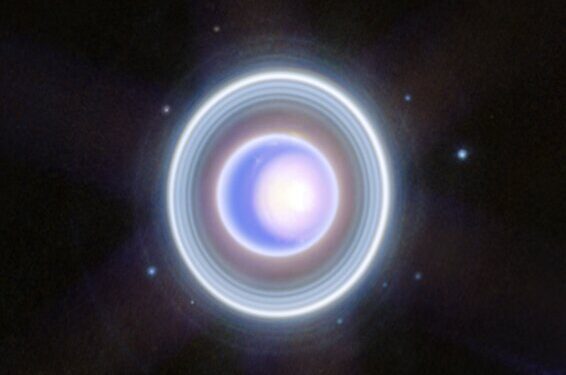This image of Uranus taken by NIRCam (near infrared camera) on NASA’s James Webb Space Telescope exquisitely captures Uranus’ seasonal north polar cap and its dark inner and outer rings. This Webb image also shows 9 of the planet’s 27 moons (clockwise from 2 o’clock), they are: Rosalind, Puck, Belinda, Desdemona, Cressida, Bianca, Portia, Juliet and Perdita. Credit: NASA, ESA, ASC, STScI
The James Webb Space Telescope recently took aim at the unusual and enigmatic Uranus, a sideways-turning ice giant. Webb captured this dynamic world with rings, moons, storms and other atmospheric features, including a seasonal polar cap. The image expands on a two-tone version released earlier this year, adding additional wavelength coverage for a more detailed look.
With his exquisite sensitivity, Webb captured the dark inner and outer rings of Uranus, including the elusive Zeta Ring, the extremely faint and diffuse ring closest to the planet. He also photographed many of the planet’s 27 known moons, and even saw some small moons inside the rings.
In the visible wavelengths seen by Voyager 2 in the 1980s, Uranus appeared as a placid, solid blue ball. In infrared wavelengths, Webb reveals a strange and dynamic ice world filled with exciting atmospheric features.
One of the most striking of these is the seasonal cloud cap over the planet’s North Pole. Compared to the Webb image from earlier this year, some details of the cap are easier to see in these more recent images. These include the bright white inner cap and the dark band at the bottom of the polar cap, towards lower latitudes.
Several bright storms can also be seen near and below the southern edge of the polar cap. The number of these storms, as well as their frequency and where they appear in Uranus’ atmosphere, could be due to a combination of seasonal and meteorological effects.
-
This wide-field image of Uranus taken by NIRCam (near infrared camera) on NASA’s James Webb Space Telescope shows the planet amid a handful of distant galaxies in the background. This image also includes 14 of the planet’s 27 moons: Oberon, Titania, Umbriel, Juliet, Perdita, Rosalind, Puck, Belinda, Desdemona, Cressida, Ariel, Miranda, Bianca and Portia. Credit: NASA, ESA, ASC, STScI
-
Annotated wide-field compass image of Uranus with some of its 27 moons and a few prominent stars (with characteristic diffraction spikes) labeled. Credit: NASA, ESA, ASC, STScI
The polar cap appears to become more prominent as the planet’s pole begins to point toward the sun, as it approaches the solstice and receives more sunlight. Uranus will reach its next solstice in 2028 and astronomers are eager to observe any possible changes in the structure of these features. Webb will help unravel the seasonal and weather effects that influence Uranus’ storms, which is essential for helping astronomers understand the planet’s complex atmosphere.
Because Uranus rotates sideways at a tilt of about 98 degrees, it experiences the most extreme seasons in the solar system. For nearly a quarter of each Uranian year, the sun shines on one pole, plunging the other half of the planet into a dark 21-year winter.
Thanks to Webb’s unmatched infrared resolution and sensitivity, astronomers now see Uranus and its unique features with revolutionary clarity. These details, especially those of the Zeta ring in close-up, will be invaluable in planning future missions to Uranus.
Uranus can also serve as a reference for studying the nearly 2,000 similarly sized exoplanets discovered in recent decades. This “exoplanet in our backyard” can help astronomers understand how planets of this size work, what their meteorology looks like and how they formed. This can in turn help us understand our own solar system as a whole by placing it in a broader context.
Provided by NASA Goddard Space Flight Center
Quote: Webb rings in vacation with the ringed planet Uranus (December 18, 2023) retrieved December 18, 2023 from
This document is subject to copyright. Apart from fair use for private study or research purposes, no part may be reproduced without written permission. The content is provided for information only.



